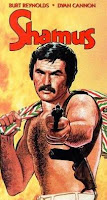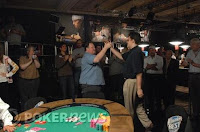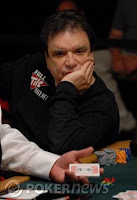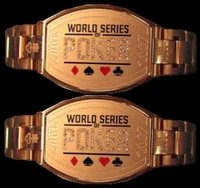
Quiet day yesterday, mostly spent at the home-away-from-home. Was off and so tried to catch up on some other reading and writing, though didn’t get too far with that. (Today’s a new day, though.)
Did go out and play some $3/$6 limit hold’em for a decent stretch (over three hours), and won a few bucks. There were a couple of okay players at the table -- no one was
checking with quad aces, anyway -- although again it was still primarily make-a-hand poker. And thankfully I made enough hands to win a little.
Meanwhile, over at the Rio All-Suite Hotel and Casino, a total of 35 bracelets have been awarded (of the 57 total) thus far at the World Series of Poker. That’s more than half, although in terms of days we are only just now reaching the halfway point. The last day of play this summer will be Wednesday, July 15, which if I’m counting right will be Day 49. I think I fly home the day after.
Day 24 of the WSOP (yesterday) saw just one bracelet won, in Event No. 35, the $5,000 Pot-Limit Omaha. Looks like that one ended with a truly kooky final hand in which the winner, Richard Austin, knocked out both Sorel Mizzi and Cliff “JohnnyBax” Josephy at once. The hand actually touches on an issue I’d been thinking about some over the last week or so -- the fact that occasionally we’ll see hands that are so odd that they become difficult to report, because they seem so strange and, well, unbelievable. Let me share the hand, then I’ll explain further what I mean.
Looking at
F-Train and
tbostic’s live blog of the final day of Event No. 35, it appears there were about 5.45 million chips in play. The final three players had reached Level 25, where the blinds were 25,000/50,000. Doing a little bit of math, it looks like when the hand began Austin had the lead with about 2.75 million (roughly half the chips), Mizzi was in second with around 1.7 million, and Josephy was the short stack with just under a million.
The hand started with Austin just calling the 50,000 from the button, then Mizzi completing from the small blind. That made the pot 150,000 when Josephy raised pot from the BB. Austin again just called, then Mizzi reraised pot. That meant Mizzi had now put in a total of 800,000 chips: 50,000 for the first call, and now he was raising “to 750,000” -- i.e., 150,000 more to call Josephy’s raise, then 600,000 to match the new pot size.
The action was on Josephy, who pushed the 795,000 he had left in the middle -- a call of Mizzi’s reraise, plus another reraise of 195,000 more. Austin decided to call, and Mizzi finds out he cannot reraise again, since Josephy’s reraise was less than half the pot. So he just calls, too, leaving himself 680,000 behind. But he’s clearly committed, now. The pot is something like 3 million, and Mizzi’s probably pushing his chips in the middle no matter what the flop is. The flop comes



, Mizzi does indeed shove, Austin calls, and the trio’s hands were then revealed.
Mizzi had




. That flop wasn’t good for him at all, as he just had a dry pair of aces and vague hopes for a backdoor diamond flush. Meanwhile, the flop was pretty darned nice for Josephy, who had




. Top set, there. Austin meanwhile was the one with the draws. He had




, both a flush draw and a gutshot straight draw.
According to Two Dimes, Josephy was ahead here with a nearly 60% shot to win the hand. Austin was about 38% percent. And Mizzi was drawing mighty thin -- about 2% to win.
The

on the turn meant Mizzi was at that point drawing dead, and Josephy was about 70% to win it. But the river was the

, and Austin took all the chips and the bracelet.
Austin’s passive preflop calls with a pretty marginal PLO hand are perhaps a bit hard to figure, though the more I think about it, I can start to see what might have been going on. He makes three calls. The first one -- limping from the button -- is not unusual at all. Limping preflop in PLO is common, and looking back through the blog, it appears there were a lot of smallish pots being played for the hour or so they had been three-handed, and so the pot-sized raises preflop were something new. The second call of Josephy’s pot-sized raise from the big blind fits with what had been going on previously as well. Austin had little reason to suspect Mizzi would try anything here, and wanted to keep the pot small and play his marginal hand with position after the flop.
When Austin makes that third call of Josephy’s all in, he pretty much knows he’s going to face another 680,000-chip bet from Mizzi after the flop, regardless of what three cards come. But if he’s not going to fold this hand before the flop -- certainly a reasonable (or, one has to say, recommended) option at this point -- he’s smart just to call here, because doing so makes it impossible for Mizzi to get all of his chips in before the flop.
When Austin makes that call, he has committed about a million chips preflop, meaning it would certainly be painful to fold this one if the flop doesn’t hit his hand. But by just calling before the flop, he leaves himself that option to fold and preserve the still 1.7 million chips he has behind should an especially crummy flop come.
Anyhow, all of this is easy to say well after the fact. But such complicated decision-making is often very hard to appreciate when you’re just trying to record bet amounts and get the cards correct. Kudos to F-Train and tbostic for their report on this last hand (and for the entire night’s worth of reporting).
Like I say, this hand in a way touches on the phenomenon I alluded to above, namely, watching a hand go down that seems a little strange -- or perhaps that makes little sense at all -- then trying to report it. You almost want to try to explain a player’s thought processes in order to justify the action. But that’s obviously not the reporter’s job (even if he or she were capable of doing it).
We saw a hold’em hand the night before at our final table in which a player called off his still-substantial stack with


on a board of



. When you see a hand like that, you start distrusting your senses, and indeed we were confirming with each other there on media row that what we saw indeed was what happened. Then we puzzled with each other over why the player made his decision. Did he actually think he was good? (His opponent had


, by the way.) Did his opponent’s constant aggression finally get to him, causing him to make what was clearly a sketchy decision? Or was he just tired and willing to gun for six outs?
It was not unlike that hand
I mentioned yesterday in which the player called Jonathan Little’s all-in bet with just
Q-J after a seven-high flop. You see it, then you look around and say “Wha?”
In fact, it just so happened Little was in the bleachers Thursday night watching our final table where the player made that call with
K-Q. I looked across and wondered if he turned to those with whom he was sitting and said something about how he’d been knocked out of the very same event.
’Cos, yeah, weird stuff happens. And believe me, we see it all the time.
Labels: *high society, 2009 WSOP
 Just got back from taking Vera Valmore to McCarran Airport. She returns home today after a week here with me in Vegas.
Just got back from taking Vera Valmore to McCarran Airport. She returns home today after a week here with me in Vegas.  As a matter of fact, someone already has. Not many have seen it, but in 1973 a feature film about me hit the theaters, directed by Buzz Kulik and starring Burt Reynolds in the title role.
As a matter of fact, someone already has. Not many have seen it, but in 1973 a feature film about me hit the theaters, directed by Buzz Kulik and starring Burt Reynolds in the title role. 





















 , Mizzi does indeed shove, Austin calls, and the trio’s hands were then revealed.
, Mizzi does indeed shove, Austin calls, and the trio’s hands were then revealed.


 . That flop wasn’t good for him at all, as he just had a dry pair of aces and vague hopes for a backdoor diamond flush. Meanwhile, the flop was pretty darned nice for Josephy, who had
. That flop wasn’t good for him at all, as he just had a dry pair of aces and vague hopes for a backdoor diamond flush. Meanwhile, the flop was pretty darned nice for Josephy, who had 


 . Top set, there. Austin meanwhile was the one with the draws. He had
. Top set, there. Austin meanwhile was the one with the draws. He had 


 , both a flush draw and a gutshot straight draw.
, both a flush draw and a gutshot straight draw.  on the turn meant Mizzi was at that point drawing dead, and Josephy was about 70% to win it. But the river was the
on the turn meant Mizzi was at that point drawing dead, and Josephy was about 70% to win it. But the river was the  , and Austin took all the chips and the bracelet.
, and Austin took all the chips and the bracelet. on a board of
on a board of 
 , by the way.) Did his opponent’s constant aggression finally get to him, causing him to make what was clearly a sketchy decision? Or was he just tired and willing to gun for six outs?
, by the way.) Did his opponent’s constant aggression finally get to him, causing him to make what was clearly a sketchy decision? Or was he just tired and willing to gun for six outs? 



 . A jack came on the turn, the river bricked, and Little left quickly and quietly, not too happy with his opponent’s crazy call. “You’ve got guts, kid,” a player said afterwards, explaining how on the flop he’d folded Q-7. (Dunno if I’d call it guts.)
. A jack came on the turn, the river bricked, and Little left quickly and quietly, not too happy with his opponent’s crazy call. “You’ve got guts, kid,” a player said afterwards, explaining how on the flop he’d folded Q-7. (Dunno if I’d call it guts.) 












